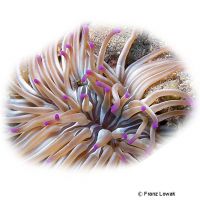Golden Anemone (Condylactis aurantiaca)
| Golden Anemone Condylactis aurantiaca | |
|---|---|
| Name | Golden Anemone |
| Name Lat. | Condylactis aurantiaca |
| Synonym | Actinia aurantiaca |
| Family | Sea Anemones |
| Family lat. | Actiniidae |
| Order | Sea Anemones |
| Order lat. | Actiniaria |
| Origin | Mediterranean Sea |
| Diet | Autotrophic, carnivore |
| pH | 8.1-8.4 |
| Hardness | 8-12 °KH |
| Lighting | Medium - high |
| Current | Moderate |
| Behavior | Aggressive |
| Keeping | Individual |
| Care Level | Moderate |
| Life Span | N/A |
| Protection | No |
| Metric Units | |
| Size | 10-30 cm |
| Temperature | 18-24 °C |
| Salinity | 33-36 ‰ |
| Aquarium | 250 l |
| US Units | |
| Size | 3.9"-12" |
| Temperature | 64-75 °F |
| Salinity | 1.020-1.025 sg |
| Aquarium | 65 gal |
Distribution and habitat
Condylactis aurantiaca occur exclusively (endemically) in the Mediterranean Sea, where they are distributed from the Balearic Islands to the Dardanelles. They live solitary mostly in the shallow water zone, their foot buried in the soft bottom but not attached at 2-10 m depth.
Maintenance
They need an aquarium with a very deep, sandy substrate to burrow into, and they should be positioned in a not-too-bright spot with moderately strong, alternating currents. Most of the time, however, they will find their own spot
Only substrates rich in lime and free of heavy metals should be used as substrate. To ensure water quality, filters, skimmers and heaters are necessary, as well as pumps to simulate tides, swells and bottom currents. It is recommended that live stones be used to set up the aquarium. The bacteria living in the porous stones act as a biological filter. The lighting must correspond to the species-appropriate day-night rhythm of the animals
| Salinity: 33-36 ‰ | pH value: 8.1-8.4 |
| Carbonate hardness: 8-12 °KH | Nitrate content: 2-8 mg/l |
| calcium content: 420-450 mg/l | Nitrite content: 0.0-0.05 mg/l |
| Magnesium content: 1.250-1.350 mg/l | phosphate content: 0.01-0.1 mg/l |
Regular addition of trace elements, especially iodine, is recommended. For salinity, an average value should be aimed for, which may only vary slightly by +/- 0.5 ‰. Ammonia and ammonium must not be measurable. Special attention shall be paid to consistently good water quality and water values.
Diet
Zooxanthellae, which are unicellular symbiotic algae, live in their tissue and provide them with assimilation products of their photosynthesis (high light requirement). The zooxanthellae promote growth and provide additional food to the plankton and small particles collected from the water current. In addition to the food produced in the aquarium during fish feeding, they must be fed specifically at least once a week with small pieces of fish, crab or shellfish meat, shrimp, krill, etc. Regular and varied feeding promotes health and avoids deficiency symptoms.
Behaviour and compatibility
It is not colonized by anemonefish and in nature only serves as a symbiotic anemone for the shrimp Periclimenes aegylios. Other animals that stick to its tentacles are devoured. A sufficiently large distance must be maintained from corals and other anemones to avoid becoming encrusted.
Reproduction and breeding
They are separately sexual. Their larvae are part of the plankton for several weeks until they settle in a suitable location. There are no known reports of successful breeding in the aquarium.
Important
Their different coloration depends on the symbiotic algae in their tissue
After being placed in the aquarium, they sometimes wander until they find a suitable place themselves. Thereby they can endanger other anemones or corals with their nettles.
Healthy animals have a closed oral disc, look "pumped up" and do not drift around.
Higher temperatures are not tolerated in the long run. Supplemental Actinic-Light (short-wave violet-blue light) illumination is very beneficial to their growth (zooxanthellae). With their strongly nettling and sticking tentacles, skin contact should better be avoided
Newly introduced animals must be acclimated slowly to the water in the aquarium. If different species are kept together, care should be taken to ensure that fish and invertebrates match each other in terms of water quality and temperature requirements, as well as their social behavior, and that the setup meets the ecological needs of all species kept together
Further literature can be found in your pet store.
References
Text: petdata; Image: Franz Lowak
Source: ENGELMANN & LANGE (2011): Zootierhaltung - Tiere in menschlicher Obhut: Wirbellose, Verlag Harri Deutsch; BAENSCH & DEBELIUS (2006): Meerwasser Atlas Bd. 1, Mergus Verlag
